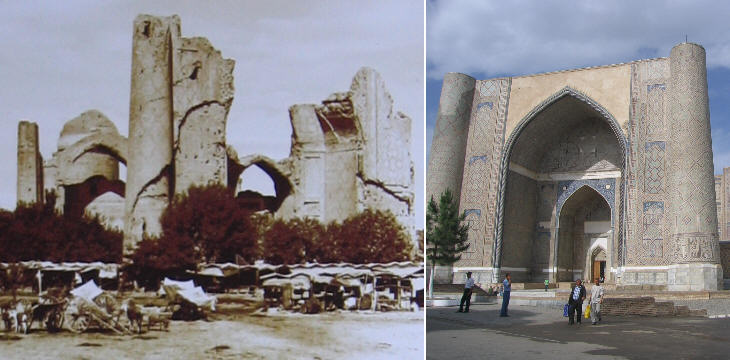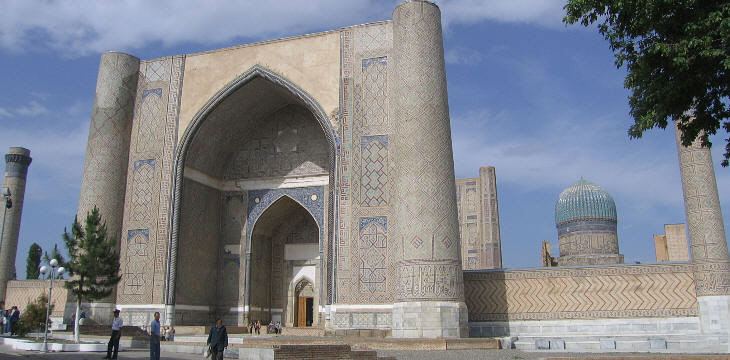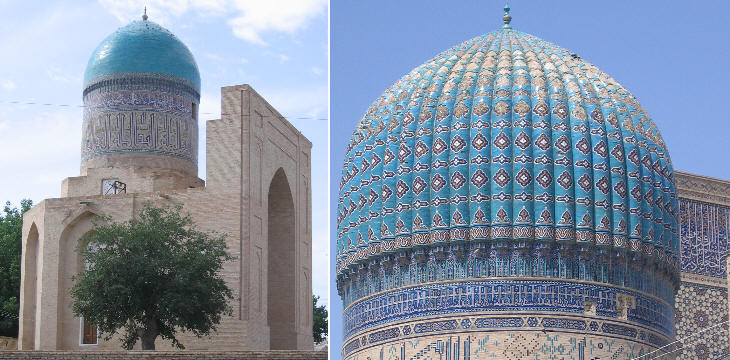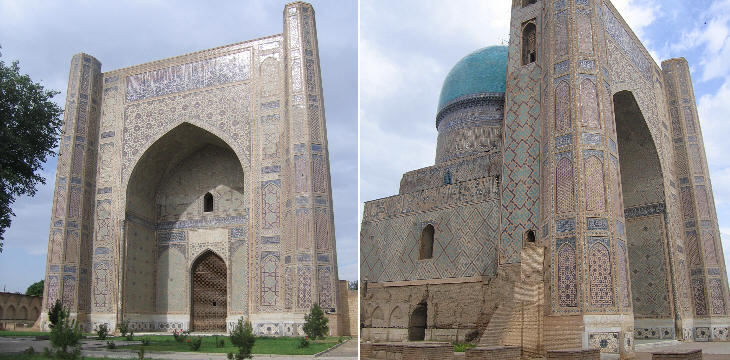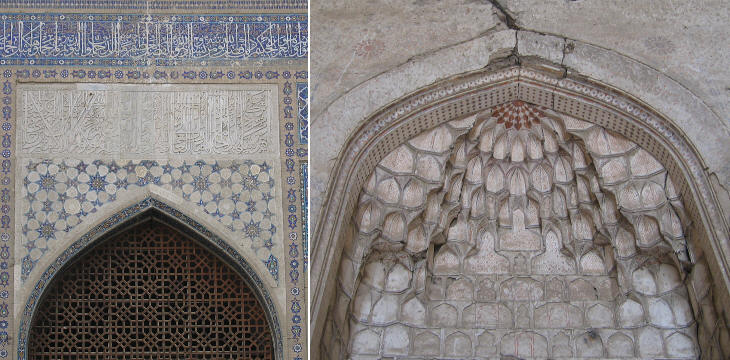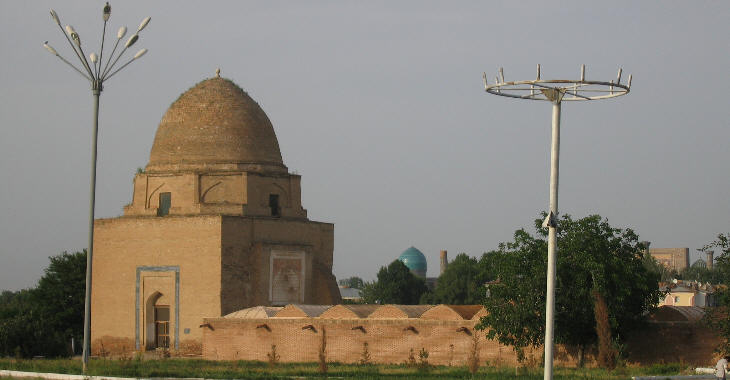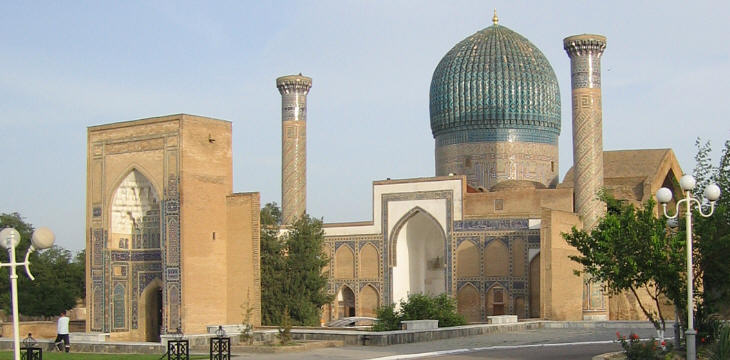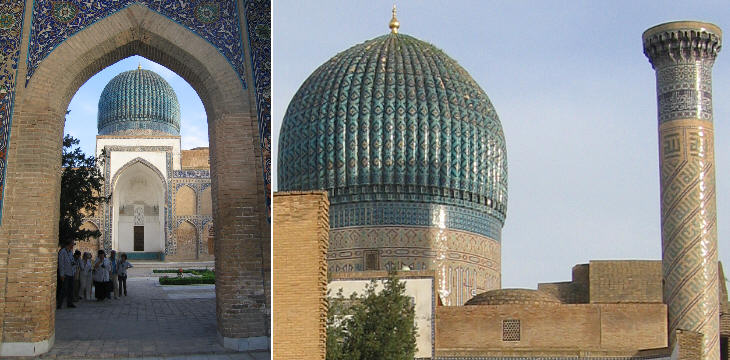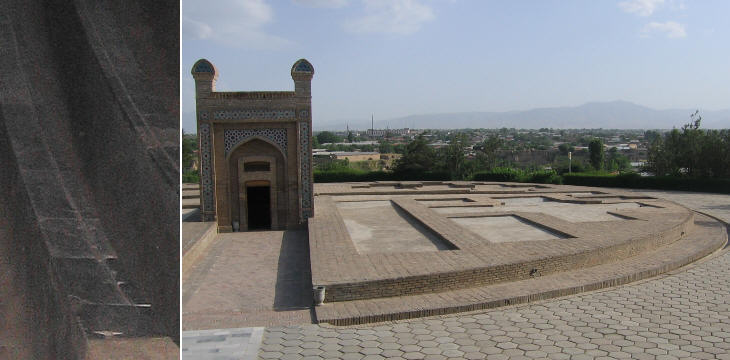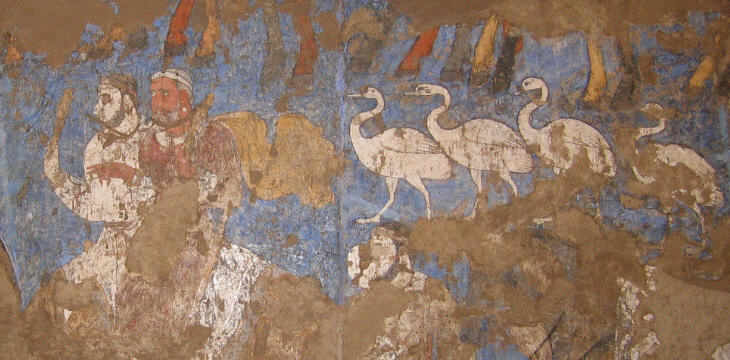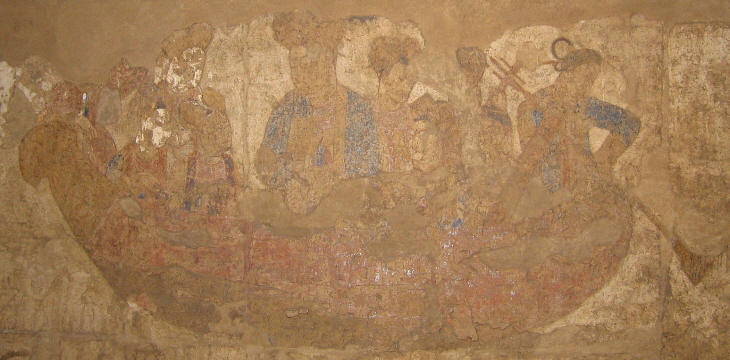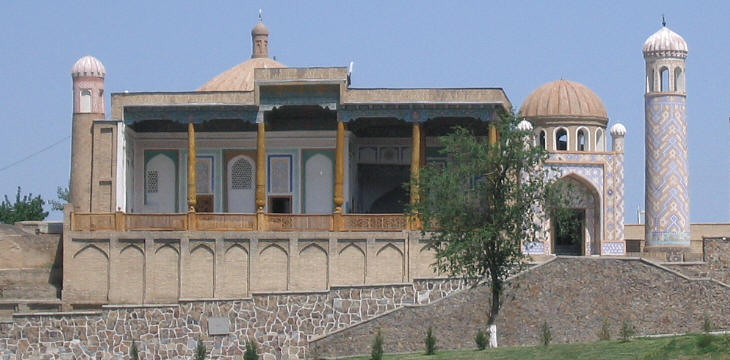  What's New! Detailed Sitemap All images © by Roberto Piperno, owner of the domain. Write to romapip@quipo.it. Text edited by Rosamie Moore. |
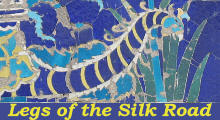 - Samarkand - page three: other monuments - Samarkand - page three: other monuments(detail of a decoration at Abdoul Aziz Khan Medrese in Bukhara) It is said that Timur brought 95 elephants from India to employ them in the construction of a gigantic mosque in Samarkand. He personally supervised its construction: he threw pieces of meat to the workers as a reward and occasionally even gold coins. Yet perhaps because it was built in a rush the complex of Bibi Khanoum soon showed construction defects.
In the 1920s only massive fragments survived of this enormous complex commissioned by Timur after his victorious campaign in India and dedicated to his wife Saray Mulk (Bibi Khanoum = Old Queen). The mosque stood at the end of a large courtyard where two smaller mosques were located. A gigantic portal was placed at the entrance of the courtyard. Its size was unprecedented: a courtesan of Timur wrote that it was larger than the Milky Way.
The whole complex has been almost entirely rebuilt; its decoration is based on that of the palace Timur built at Chakhrisabz, his hometown. A covered bazaar linked this complex to Registan. Today's Samarkand does not retain its old network of streets. During the Soviet period large alleys and modern buildings replaced them, so the city's imposing monuments lack a proper context.
The complex of Bibi Khanoum included a medrese and a mausoleum which were located opposite the portal of the mosque. The medrese was the first building to show construction defects and to be severely damaged. The mausoleum (Saray Mulk Khanoum) in the 1920s was in a ruinous state; its reconstruction was completed very recently. Very few domes of Samarkand are original: their design shows that the architects were not able to cover with a dome a wide space and that they did not dare to open windows in the drum or the dome itself. A feature of many Samarkand domes is their "ribbed" aspect and the fact that they consist of two domes; the interior ones have a traditional sphericonical shape while the exterior ones are larger than the drums which support them; this gives them a bulbous shape.
The restoration/reconstruction of Bibi Khanoum is not completed yet and maybe it will be left as it is now (2008). The side view shows a section of the original walls and an opening which gives access to the interior.
While the exterior of the mosque has been decorated with new tiles, its interior retains traces of painted plaster and gilded papier mache.
The mausoleum dedicated by Timur to Sheikh Burhan al–Din Sagarji has a rather ancient appearance. Sheikh Burhan al–Din Sagarji was a holy man highly revered at the time of Timur. It is said that he was buried with a box containing some hair of Prophet Muhammad. The mausoleum is known as Roukhabad which means (the building which) houses the soul. It is now surrounded by very busy roads. In the past a paved street linked it with the mausoleum of Emir Gour (which can be seen in the distance).
Gour Emir means the tomb of the sovereign. Timur built it as the resting place of his grandson Muhammad Sultan, who died in battle in 1403 at the age of 29. Muhammad Sultan built a medrese and a khanagha, a monastery for the dervishes and Timur decided to add a mausoleum for his grandson. He eventually wanted to be buried there as did his sons and grandsons, so that Gour Emir can be regarded as the Timurid dynastic tomb. The mausoleum was built on the southern side of a walled square courtyard already defined on two sides by the medrese and the khanagha (which no longer exist).
Minarets marked each corner of the courtyard, two of which remained in part and have been reconstructed. A ribbed dome on a tight high drum is visible from a great distance. The dome is tiled in two tones of blue. The minarets were decorated with bands of tiles forming a monumental Kufic inscription which repeats God is eternal.
Ouloug Beg, Timur's grandson, built one of the earliest Islamic astronomical observatories on the ruins of the ancient city of Afrasiab, in the outskirts of Samarkand. The underground sections of its gigantic marble sextant were unearthed in 1908. After its founder assassination in 1449 the site was abandoned. The observatory consisted of three astronomical instruments, the main one being a sextant running through the centre of the building; it was placed along the north-south axis. This quadrant, with incised Arabic symbols and numerals on marble slabs was partly hewn into rock. Based on contemporary descriptions, the observatory had a circular shape and it was decorated with glazed brick mosaics on the exterior, while the interior had paintings depicting heavenly bodies.
Afrasiab (beyond the river) is the name which was eventually given to the ruins of ancient Samarkand. In 1965 archaeologists identified a building which was most likely the residence of the city's rulers. A large room was decorated with three large Vth century frescoes depicting scenes related to a royal wedding. Notwithstanding the effects of time and the Muslims scraping out the eyes of many personages they retain much of their original elegance.
The bride was a Chinese princess and the painter too was most likely a Chinese. The scene above portrays the bride while she is being carried to the royal palace on a boat.
The building shown above is both one of the oldest and one of the newest mosques of Samarkand. It was built by the Arabs when they conquered Samarkand in the VIIth century on the site of a temple. However it was rebuilt several times, the last one in the XIXth century. Go to Samarkand - page one or to Samarkand - page two Introductory page Bukhara Khiva Chakhrisabz  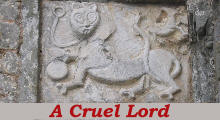  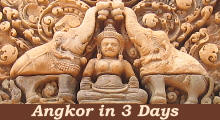 |
